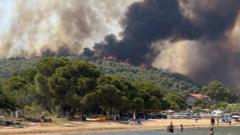
Wildfires Force Evacuations in Halkidiki and Crete
Hundreds of residents and tourists have been evacuated as wildfires continue to rage across Halkidiki and the island of Crete, Greece. The blazes, fueled by strong winds and high temperatures, have prompted emergency responses from local authorities and international assistance.
Situation Overview
The fires initially broke out in multiple locations, quickly spreading due to the prevailing dry conditions and powerful gusts. The affected areas include densely forested regions and areas near residential zones, necessitating immediate evacuation orders to ensure public safety.
Halkidiki Update
In Halkidiki, the fires are concentrated in the northeastern part of the peninsula. Several villages have been placed under mandatory evacuation orders, with residents being relocated to safer areas, including nearby towns and designated shelters. Firefighting teams are working tirelessly to contain the blazes and prevent further spread towards populated areas and critical infrastructure.
Crete Update
The island of Crete is also grappling with significant wildfire activity, particularly in the regional unit of Rethymno. The fires have caused extensive damage to agricultural land and natural habitats. Evacuations have been carried out in coastal communities and mountainous villages as a precautionary measure. The challenging terrain is hampering firefighting efforts, requiring the deployment of specialized equipment and aerial support.
Emergency Response Efforts
Greek authorities have mobilized all available resources to combat the wildfires, including firefighters, emergency responders, and volunteers. Water-bombing aircraft and helicopters are being utilized to suppress the flames from above, while ground crews are working to create firebreaks and protect vulnerable properties. International assistance has been requested and is being coordinated through the European Union Civil Protection Mechanism.
Key Response Actions:
- Evacuations: Prioritizing the safe removal of residents and tourists from high-risk areas.
- Fire Suppression: Deploying firefighting teams and aerial support to contain and extinguish the blazes.
- Resource Allocation: Distributing firefighting equipment, water supplies, and logistical support to affected regions.
- Shelter and Aid: Providing temporary housing, food, and medical assistance to evacuees.
- Coordination: Ensuring effective communication and collaboration between local, national, and international agencies.
Contributing Factors
Several factors have contributed to the severity and rapid spread of the wildfires, including:
- Extreme Heat: Record-breaking temperatures have created tinderbox conditions.
- Strong Winds: Powerful winds have fanned the flames and carried embers over long distances.
- Dry Vegetation: Prolonged periods of drought have left forests and grasslands highly flammable.
- Climate Change: Experts warn that climate change is exacerbating the risk of wildfires globally.
Impact and Aftermath
The wildfires have had a devastating impact on the affected regions, causing significant property damage, ecological destruction, and economic disruption. The long-term consequences of the fires are still being assessed, but recovery efforts are expected to be extensive and require substantial investment.
Anticipated Challenges:
- Rebuilding damaged infrastructure and homes.
- Restoring affected ecosystems and agricultural land.
- Providing support to displaced communities.
- Implementing measures to prevent future wildfires.
Looking Ahead
As the wildfires continue to burn, authorities are urging residents and tourists to remain vigilant and follow official guidance. The focus remains on containing the blazes, protecting lives and property, and providing assistance to those affected. The long-term recovery process will require a concerted effort from all stakeholders to rebuild and restore the affected regions.
